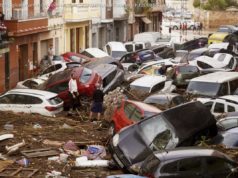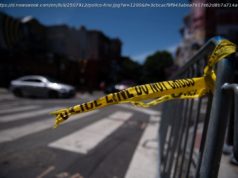With four big hurricanes, a powerful earthquake and wildfires, it seems that nature recently has just gone nuts.
WASHINGTON (AP) – With four big hurricanes, a powerful earthquake and wildfires, it seems that nature recently has just gone nuts.
Some of these disasters, like Friday’s earthquake in Mexico, are natural. Others may end up having a mix of natural and man-made ingredients after scientists examine them. We also always tend to look for patterns and order in chaos, even when they aren’t there, psychologists say.
“Nature’s gone crazy, ” mused Jeff Masters, meteorology director at the private service Weather Underground. “Welcome to the future. Extreme weather like this is going to be occurring simultaneously more often because of global warming.”
A look at a rough few weeks in North America:
HURRICANE QUARTET
Hurricane Harvey hadn’t even fizzled and Houston hadn’t even dried out from record flooding before Hurricane Irma formed and also grew into a powerful Category 4 storm. Right behind Irma, Jose has powered up to a Category 4 storm. It is highly unusual, but not unprecedented to have back-to-back storms of that strength, Masters said. And then there is Hurricane Katia, just a shade under major hurricane status, due to hit Mexico’s Gulf coast.
The last couple of years were quiet for Atlantic hurricanes, which makes this year seem even worse, said Colorado State University meteorology professor Phil Klotzbach, a hurricane expert. He said calculations that measure strength and duration show the three current Atlantic storms set a one-day record for energy on Friday. In just three days, Irma, Jose and Katia have produced as much as energy as about half a normal six-month hurricane season.
EARTHQUAKE
As Mexico was bracing for Katia off the Gulf coast, one of the strongest earthquakes in the country’s history hit late Thursday off its Pacific coast, near the Guatemala border. The magnitude 8.1 earthquake was felt for more than 650 miles (1,000 kilometers) . The quake shook at a depth of 43 miles (69 kilometers) and a quake hitting at that depth with that strength is unusual, according to Cornell University geophysics professor Geoff Abers. It was one of the five largest for that deep in the past 40 years, he said.
WILDFIRES
On Friday, 82 wildfires were burning in the United States involving nearly 1.5 million acres in nine states in the West. So far this year, more than 8 million acres have burned, only behind 2015 and 2012. One fire at the Rogue River-Siskiyou National Forest in Oregon has burned more than 175,000 acres and is only 5 percent contained as of Friday, according to the National Interagency Fire Center.
Drought and a heat wave contributed. On Sept. 1, in normally temperate San Francisco, the temperature hit 106 degrees and at least six deaths were reported from the heat wave.
WHAT’S GOING ON HERE?
Sometimes there’s a pattern in chaos. Sometimes there isn’t. Looking for patterns gives us a sense of control, even if we don’t really have it, said Scott Lilienfeld, a psychology professor at Emory University in Atlanta. “The human mind is a pattern-seeking organ, ‘” he said. “That’s how our minds work.”
It can take weeks or months for scientists to determine whether an extreme weather event was worsened by man-made climate change. But scientists have long predicted that the strongest hurricanes will get stronger and wetter, fueled by warmer ocean water. And some say the recent global increase in powerful hurricanes fits perfectly with global warming.
While warming may play a small role, so does Twitter and Facebook in making things appear worse, said Klotzbach.
“It just feels like, you know, it’s the apocalyptic end times, ” he said. “But a lot of this stuff is getting attention because of social media.”
___
Researcher Monika Mathur contributed to this report.
___
Follow Seth Borenstein on Twitter at @borenbears. His work can be found here.
Copyright 2017 The Associated Press. All rights reserved. This material may not be published, broadcast, rewritten or redistributed.






